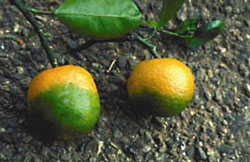13
Nov
Sound Waves Disrupt Mating of Pest in Orange Groves
(Beyond Pesticides, November 13, 2015) Research finds that sound waves could combat the Asian citrus psyllid, an insect that has been devastating Florida orange groves, and possibly reduce the need for pesticides. The Asian citrus psyllid carries a bacteria that causes “citrus greening,” an incurable disease with symptoms that include yellow shoots, uneven discolored patches, and deficiencies with the production of chlorophyll, green pigment found within plants. To stem the spread of the disease —which is responsible for an estimated $3.63 billion in lost revenue from orange juice for the state of Florida from 2006-2012— researchers at the U.S. Department of Agriculture (USDA) and University of Florida (UF) are developing vibration traps that hijack psyllid mating calls to locally bring their populations under control.
 “We’re trying hard to cut down on use of pesticides in orange groves, partly because we are worried they’ll build up resistance to pesticides, and that will make things even worse,” said Richard Mankin, Ph.D., a research entomologist with USDA. He presented findings on acoustic disruption at the meeting of the American Acoustical Society last month in Jacksonville.
“We’re trying hard to cut down on use of pesticides in orange groves, partly because we are worried they’ll build up resistance to pesticides, and that will make things even worse,” said Richard Mankin, Ph.D., a research entomologist with USDA. He presented findings on acoustic disruption at the meeting of the American Acoustical Society last month in Jacksonville.
When a male Asian psyllid is looking for a mate, he situates himself on a twig and alerts females by buzzing his wings to send vibrations along adjacent leaves and branches. To disrupt that activity, researchers created a device containing a buzzer and a microphone wired to a microcontroller. The device detects the incoming male call and emits a fake female response call through the buzzer before any neighboring psyllids can answer. When the male bug comes near the device, he gets snagged and immobilized on an adhesive surface. In lab tests, the insects subjected to the noise were four times less likely to find a mate than other psyllids.
USDA has pushed for alternative methods in combatting citrus greening in the past. In 2014, USDA broadened the use of tiny parasitic wasps, Tamarixia radiata. The agency is already committed to provide $1.5 million dollars to the T. radiata breeding and release program in California, Texas, and Florida. Congress also allocated more than $125 million dollars over the next five years to fund more research on containing the spread of the Asian citrus psyllid.
In addition to threatening the citrus industry, the disease has caused significant difficultly between beekeepers and citrus farmers who are combating the spread of the psyllid with toxic chemicals. Local beekeepers are worried over the increasing use of harmful neonicotinoid pesticides, a class of chemicals linked to the worldwide bee decline, and citrus growers are concerned about the increasing population of Asian citrus psyllids.
The proven effectiveness of biological agents such as parasitic wasps, as well other alternative measures such as sound waves, show that the use of lethal pesticides is unnecessary. Additionally, farm operations that are USDA certified organic already avoid the use of toxic chemicals by implementing organic systems plans that can include biological pest management. To learn more about the policies and management strategies of organic agriculture, please visit Beyond Pesticides’ Keeping Organic Strong page.
Source: Takepart
All unattributed positions and opinions in this piece are those of Beyond Pesticides.










